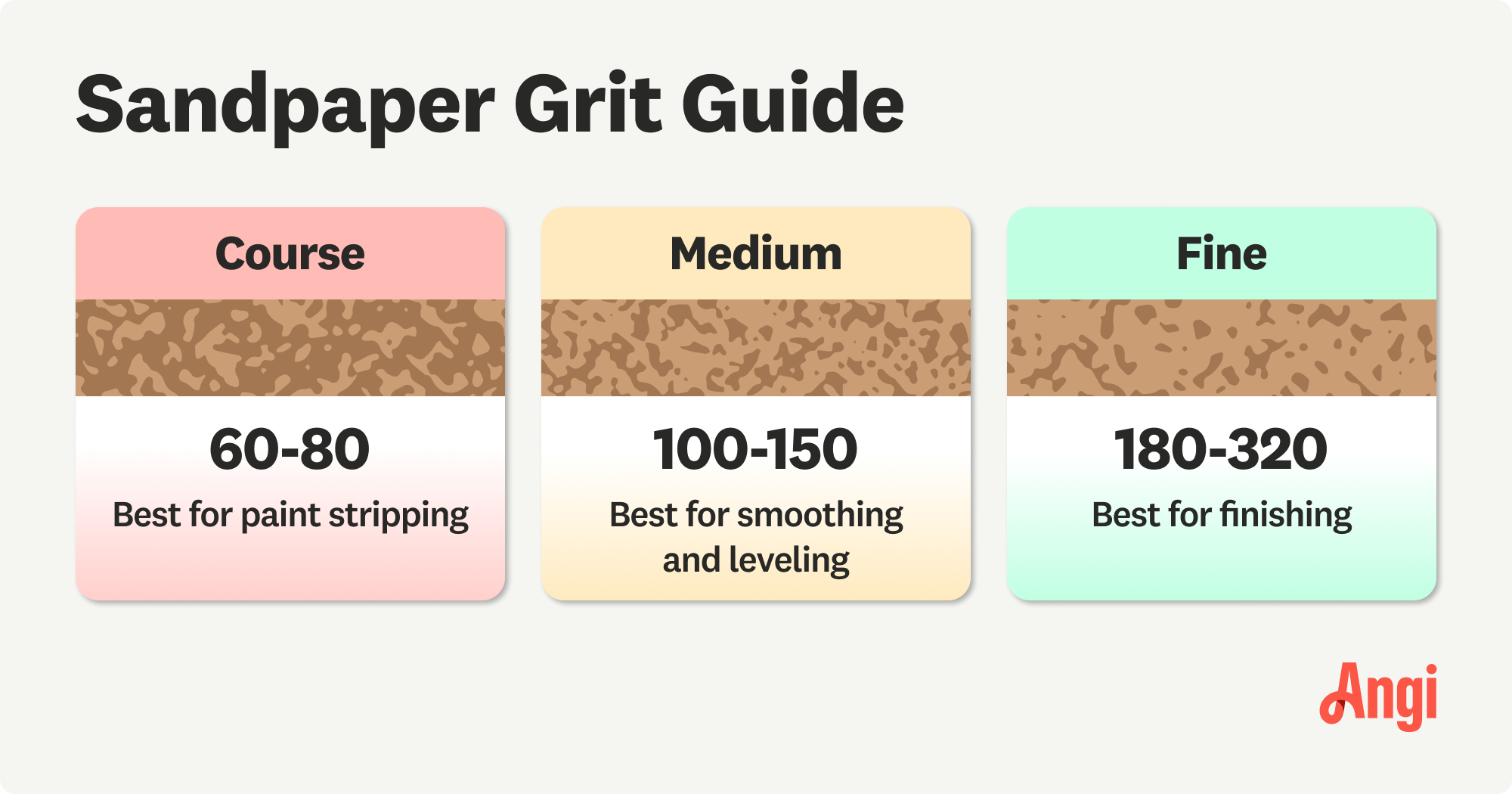
The cost to stain a deck varies depending on its size, location, and type of stain. Keep reading to learn more about how much you might spend.
A little grit goes a long way when deck sanding


Learning how to sand your deck will refresh the wood and prepare it for a new coat of stain. By sanding first, you extend your deck’s life, appearance, and durability.
Sanding with an oscillating or orbital sander is the best way to sand a deck because it removes grime, old stain or paint, and the topmost layer of wood while being easy to handle. Follow these steps for sanding a deck and achieve smooth, long-lasting results.

Deck yourself out with the right tools and supplies to achieve a beautiful finish.
You can’t go wrong with using a random orbital sander or oscillating spindle sander to sand your deck. Since decks are usually made of softwood, belt sanders can gouge the wood and cause permanent damage. On the other hand, random orbital sanders and oscillating spindle sanders are gentler, easier to handle, and give it an even finish, especially if you’re not an experienced woodworker.
If you have a railing with posts or other detailing on your deck, switch to a multi-tool or detail sander when working around the intricate areas. You can buy power sanders or rent them from a home improvement store.
What grit sandpaper is best for deck sanding? Opt for 60- or 80-grit sandpaper on your deck boards and stairs and 80- or 100-grit for the posts and handrails. If your deck has more wear and tear or a rougher finish, choose a lower grit number to remove more of the surface.
Cleaning your deck helps remove grime, mildew, and dirt before you sand it. If you skip the cleaning step, it makes sanding more difficult and time-intensive.
Clear your grill, furniture, potted plants, and other items from the deck. Clean your painted deck by mopping or spraying a non-toxic, biodegradable deck cleaner. You can also make a homemade deck cleaner solution by mixing two gallons of warm water and two cups of powdered oxygen bleach in a bucket. Stir in ¼ cup of liquid dish soap and you’re ready to go. Scrub with a soft bristle broom or deck scrub brush and rinse with water.
Instead of using deck cleaner, you can gently power wash your deck. Be sure to put it on a low setting with a spray nozzle so it doesn't damage your wood finish.
After you clean your deck, you can apply a deck and wood brightener to boost the appearance of your wood. If your deck is more than 10 years old or has grayed with time, a deck brightener can make a noticeable difference. Let the wood dry fully before sanding your deck, usually 24 to 48 hours after the last cleaning or rainfall.
Over time, your deck can accumulate gouges, splitting wood, and loose nails. Look over your deck boards, stairs, and railings. Replace damaged boards and fill in grooves and holes with wood filler and a putty knife. Secure any loose boards with screws or nails.
With a nail punch and hammer, tap in any nails that are sticking out. With a power screwdriver, secure any loose deck screws (or replace them with new screws). Screws and nails that are sticking out could rip your sandpaper.
Before sanding your deck, look at the weather forecast to find three days in a row or more without rain. Your wood should be dry before you sand it, and it should remain dry until you apply stain and let it cure. You don’t want your deck to get wet after you sand it but before you stain it. Water raises the wood grain, and you’ll have to resand the deck.
Wear safety glasses and a dust mask while sanding to avoid wood dust from coming in contact with your eyes and lungs. Put on hearing protection, too. Consider using knee pads or a kneeling cushion for extra comfort.

Attach your 60- or 80-grit sandpaper to your sander. Sand with medium pressure across your deck boards. Start in the corner of the deck and work your way across it. The best way to sand a deck is in the direction of the wood grain, so you don't damage the timber. Aim for evenness, not a perfectly smooth surface. Digging too much into the wood with your sander can cause permanent gouges.
Sand your stair treads the same way, going with the grain of the wood. If you feel like the deck needs extra smoothing in certain areas, vacuum off the initial dust then sand with 80-grit or 100-grit sandpaper.
Next, use a detail sander equipped with 80-grit sandpaper to buff the outer edges of your deck boards. An orbital or oscillating sander is too large to fit in these grooves.
The perimeter edges of your deck and around your railing spindles are the most important, but you can also touch up the edges of each deck board, especially if they have splintering or aged wood. Aim to sand evenly to ensure the wood absorbs stain uniformly.

It’s time to take on your deck’s railings and posts. With a detail sander or hand sander, sand the railings and posts with 80-grit sandpaper. Use a 120-grit sand sponge on the edges of the railing for an extra smooth finish and to avoid hand splinters.
While sanding these finer details and surfaces takes time, it's worth the effort. Railings are often the most visible feature of a deck, so it's important to smooth them (but not too much, as it could prevent the stain from penetrating).
Use a shop vac to vacuum the entire deck, stairs, and railings. Wipe away the remaining dust with a tack cloth, especially in corners and crevices. If dust remains on the surface, the stain doesn’t adhere as well and it can affect the quality of the finish.
Seal or stain your deck as quickly as possible after sanding to avoid damage to untreated wood. Then, all that’s left is to do is maintain your deck by cleaning it yearly and resealing it every three years.
Sanding a deck yourself is cheaper than hiring a professional for the job. Most homeowners will need to rent a floor sander, which costs between $40 to $70 per day. The price is usually prorated for longer periods of time, with the average cost to rent a sander for a full week being $150 to $250. If you’re not up to the DIY project, the cost to refinish a deck professionally ranges from $900 to $2,720.
Sanding isn’t the only deck-related maintenance task. It’s a good practice to give the deck a good power wash to eliminate grime. Power washing a deck typically costs $100 to $250, though can shoot up to $500 or more in extreme circumstances. This cleaning project keeps the deck free of gross mold and mildew, which can lead to premature repairs and a shorter life span.
Sanding your deck is a straightforward process if you have the right tools, but it can take a half day or longer, depending on the size of your deck. If you don’t want to give up a free weekend or don’t have an orbital sander, consider hiring a local deck repair pro. They can ensure your deck has a smooth, even finish and can even stain it for you.
From average costs to expert advice, get all the answers you need to get your job done.

The cost to stain a deck varies depending on its size, location, and type of stain. Keep reading to learn more about how much you might spend.

Painting your house increases curb appeal and durability, but you may need to rent a lift for the project. Here’s a breakdown of cost by lift type and height.

Looking to give your fence a refresh? This guide explores the cost to stain a fence—and the cost to paint it, too— so you can budget for your project.
Painting or staining wood surfaces can give your home an entirely different look. If you aren’t sure which way to go, use this guide to decide which one is best for your next project.

What’s the difference between interior and exterior paint? Knowing how they vary is key to understanding why you should never substitute one for the other.

Finding out which paint shades do and don’t pair well with gray will help you choose the right front door color for a gray house, no matter your setup.